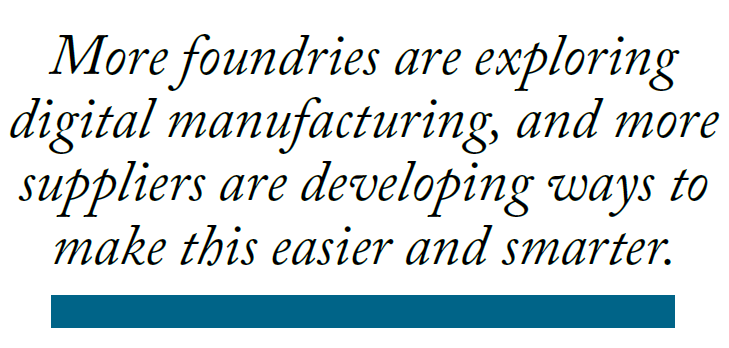Connecting the Dots in Technology
In my 15 years covering the metalcasting industry, I’ve seen a considerable amount of change in how foundries are using technology in their operations. If you asked me when I first started at Modern Casting what a more sophisticated foundry might look like, I might have said something like “more robots.” It’s true we see more robots and mechanical automation, but the change I didn’t see coming was how foundries would be using data to connect their systems for better process control and efficiency. A futurist, I am not!
Many foundry engineers I’ve talked with over the years saw the importance in collecting data and understood that knowledge should help reduce costs, shorten lead times, improve quality and be more proactive in fixing potential problems before they happen. But for years, it seemed a lot of information was being recorded, but interpreting the data into something actionable was a major obstacle.
That obstacle seems to be shrinking. More foundries are exploring digital manufacturing, and more suppliers are developing ways to make this easier and smarter. I’m looking forward to hearing about how the industry is implementing technology at the Foundry 4.0 conference AFS is hosting this June at Eaglewood Resort & Spa (Itasca, Illinois).
The conference will explore how digital manufacturing is affecting all areas of the casting process today and how it could change the foundry of the future. Topics include data collection and management, data driven decision-making, wearable technology, robotics, and artificial intelligence, as well as the related issues of workforce development, recruiting and training.
In Rich Jefferson’s article on electric vehicles this issue (What Will the Rise of Electric Vehicles Mean for Metalcasters?), the point that there is a coming disruption in the automotive industry is well documented. Supply chains are changing—some dramatically so. How will the foundry industry react? Digital manufacturing could be a major factor.
The North American foundry industry is also going through a period of investment and plant expansions. At least five new plants are planned or currently under construction, and many others have millions of dollars of capital investments ongoing to modernize their facilities.
Covering how metalcasting businesses are incorporating cutting-edge technology and automation will be an important topic for Modern Casting to explore in the year ahead, including a special issue focusing on Foundry 4.0 in April.
The metalcasting industry faces many challenges, but this is also an exciting time to watch how foundries respond.
My daughter’s 4th grade teacher encouraged her students to develop a growth mindset vs. a fixed mindset. It’s a common but newer teaching strategy to establish a psychology for success. Basically, individuals with a growth mindset believe intelligence can be developed, while those with a fixed mindset view intelligence as static. Those with a fixed mindset see the success of others and feel threatened, while those with a growth mindset are inspired. A fixed mindset will give up easily when they see an obstacle and avoid challenges, while a growth mindset persists in the face of setbacks and embraces challenges.
These distinctions can apply to the foundry industry. Is your business fixed or static? Has it plateaued? Or do you see a way for it to reach ever higher levels of achievement, today and tomorrow?
I look forward to hearing your stories of growth and sharing them with our Modern Casting readers.
Click here to see this story as it appears in the February 2020 issue of Modern Casting.